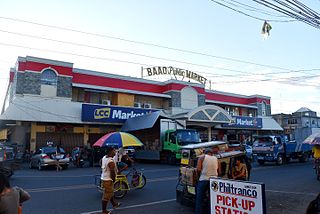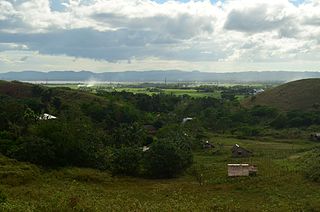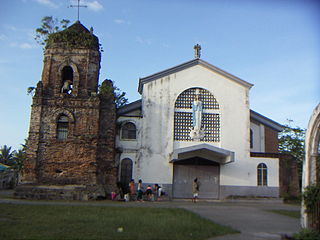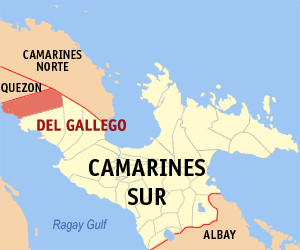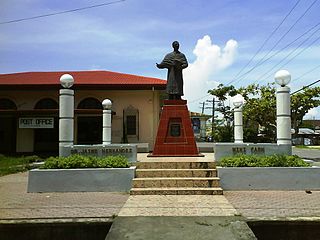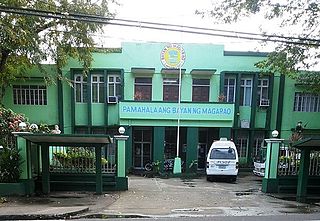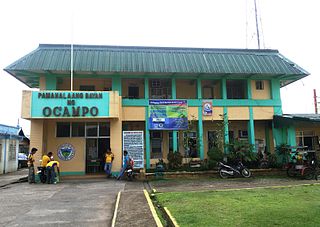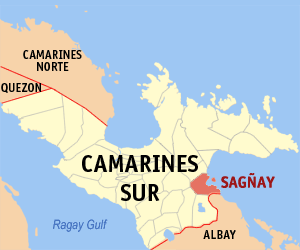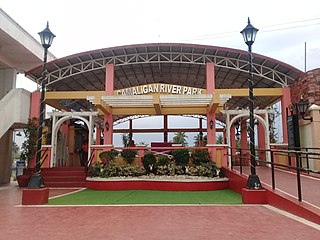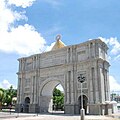Camaligan | |
|---|---|
| Municipality of Camaligan | |
 | |
| Etymology: Tagalog: kamalig + an ("place of sheds") | |
| Nickname(s): The Small Town with a Big Heart | |
| Anthem: Camaligan Kong Namomótan My Beloved Camaligan | |
 Map of Camarines Sur with Camaligan highlighted | |
Location within the Philippines | |
| Coordinates: 13°37′30″N123°09′25″E / 13.625°N 123.1569°E Coordinates: 13°37′30″N123°09′25″E / 13.625°N 123.1569°E | |
| Country | |
| Region | Bicol Region (Region V) |
| Province | Camarines Sur |
| District | 3rd district |
| Barangays | 13 (see Barangays) |
| Government | |
| • Type | Sangguniang Bayan |
| • Mayor | Marilou Marquez-Hirose |
| • Vice Mayor | Diano S. Ibardaloza, Jr. [2] |
| • Municipal Council | Members [2]
|
| • Congressman | Gabriel H. Bordado Jr. |
| • Electorate | 15,562 voters (2019) |
| Area | |
| • Total | 4.68 km2 (1.81 sq mi) |
| Population (2015 census) [4] | |
| • Total | 24,109 |
| • Density | 5,200/km2 (13,000/sq mi) |
| Demonym(s) | Camaligueño (masculine) Camaligueña (feminine) |
| Time zone | UTC+8 (PST) |
| ZIP code | 4401 |
| PSGC | |
| IDD : area code | +63 (0)54 |
| Climate type | tropical rainforest climate |
| Income class | 5th municipal income class |
| Revenue (₱) | 58,700,476.23 (2016) [5] |
| Poverty incidence | 18.45% (2012) [6] |
| Native languages | Central Bikol Tagalog |
| Feast date | June 13 (Poblacion) |
| Catholic diocese | Archdiocese of Caceres |
| Patron saints | St. Anthony of Padua St. Teresa of Calcutta |
Camaligan, officially the Municipality of Camaligan, is a 5th class municipality in the province of Camarines Sur, Philippines. According to the 2015 census, it has a population of 24,109 people. [4]

Camarines Sur is a province located in the Bicol Region in Luzon of the Philippines. Its capital is Pili and the province borders Camarines Norte and Quezon to the northwest, and Albay to the south. To the east lies the island province of Catanduanes across the Maqueda Channel.

The Philippines, officially the Republic of the Philippines, is an archipelagic country in Southeast Asia. Situated in the western Pacific Ocean, it consists of about 7,641 islands that are broadly categorized under three main geographical divisions from north to south: Luzon, Visayas and Mindanao. The capital city of the Philippines is Manila and the most populous city is Quezon City, both part of Metro Manila. Bounded by the South China Sea on the west, the Philippine Sea on the east and the Celebes Sea on the southwest, the Philippines shares maritime borders with Taiwan to the north, Japan to the northeast, Vietnam to the west, Palau to the east, and Malaysia and Indonesia to the south.
Contents
- Barangays
- History
- Etymology
- Pre-colonial era
- Spanish era
- American era
- Culture
- Festivals
- Demographics
- Climate
- Economy
- Tourism
- Government & Politics
- Educational institutions
- High School
- Elementary Schools
- Preschools
- Archaeology
- Notable people
- References
- External links
With an area of 468.8 hectares (1,158 acres), it is the smallest municipality in Camarines Sur, but it is the densest, having an approximation of 5,200 persons per square kilometer, [7] which is almost twice the density of the neighboring City of Naga of 2,456 per square kilometer. [8]

Naga, officially the City of Naga, or simply Naga City, is a 2nd class independent component city in the Bicol Region, Philippines. According to the 2015 census, it has a population of 196,003 people.
The town is home to the oldest known pre-colonial site in the Bicol region, dating 500 AD to 600 AD, making it an undeclared important archaeological zone. [9]

An archaeological site is a place in which evidence of past activity is preserved, and which has been, or may be, investigated using the discipline of archaeology and represents a part of the archaeological record. Sites may range from those with few or no remains visible above ground, to buildings and other structures still in use.








